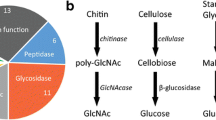Abstract
The purification and some molecular properties of six lysozymes from the gills of different mytilids and vesicomyids are described: they belong to the previously described Invertebrate lysozyme family. The predominance of the bacterial nutrition in these organisms seems to necessitate the presence of a lysozyme as in the case of the ruminant digestion model.
Similar content being viewed by others
References
Beauchamp B, Harrison C, Nassichuck WW, Eliuk LS(1989) Lower cretaceous (Albian) serpulid-bivalve carbonate “mounds” related to hydrocarbon seep. Canadian Attic Archipelago. In: Geldsetzer HHet al. (eds) Reefs, Canada and adjacent area. Can Soc Petrol Geol Mem 13:706–712
Campbell KA (1992) Recognition of a Mio-Pliocene cold seep setting from the Northeast Pacific convergent margin, Washington USA. Palaios 7:422–433
Cavanaugh CM (1993) Methanotroph-invertebrate symbioses in the marine environment: ultrastructural, biochemical and molecular studies. In: Microbial growth on C, compounds. Intercept, Andover, UK
Childress JJ, Fisher CR (1992) The biology of hydroytermal vent animals: physiology, biochemistry and autotrophic symbioses. Oceanogr Mar Biol Annu Rev 30:337–444
Dobson DE, Prager EM, Wilson AC (1984) Stomach lysozymes of ruminants I. J Biol Chem 259:11607–11616
Fiala-Médioni A (1984) Mise en évidence par microscopie électronique à transmission de l'abondance de bactéries symbiotiques dans la branchie de Mollusques bivalves de sources hydrothermales profondes. C R Acad Sci Paris 298(17):487–492
Fiala-Médioni A, Felbeck H (1990) Autotrophic process in invertebrates-nutrition: bacterial symbiosis in bivalve molluscs. In: Mellinger J (ed) Animal nutrition and transport processes I. Nutrition in wild and domestic animals. Kinne RKH, Kinne-Saffran E, Beyenbech KM (eds) Comparative physiology. Basel, Karger 5:49–69
Fiala-Médioni A, Le Pennec M (1987) Trophic structural adaptations in relation with the bacterial association of bivalve molluscs from hydrothermal vents and subduction zones. Symbiosis 4:63–74
Fiala-Médioni A, Felbeck H, Childress JJ, Fisher CR, Vetter RD (1990) Lysosomic resorption of bacterial endosymbionts in deep-sea bivalves. Endocytobiology IV. Nardon P, Gianinazzi-Pearson V, Grenier AM, Margulis L, Smith DC (eds) INSA, Villeurbanne, France, pp 335–338
Fiala-Médioni A, Michalski JC, Jollès J, Alonso C, Montreuil J (1994) Lysosomic and lysozyme activities in the gill of bivalves from deep hydrothermal vents. C R Acad Sci Paris 317:239–244
Fisher CR (1990) Chemoamotrophic and methanotrophic symbiose in marine invertebrates. Aquatic Sci 2 (3,4): 399–436
Gaillard C, Rolin Y (1988) Relation entre tectonic synsedimentaire et pseudobiohermes (Oxfordien de Beauvoisin-Drome-France). Un argument supplémentaire pour interpréter les pseudobiohermes comme formes au droit de sources marines. C R Acad Sci Paris Sér II 307:1265–1270
Gaillard C, Rio M, Rolin Y, Roux M (1992) Fossil chemosynthetic communities related to vents or seeps in sedimentary basins: the pseudobioherms of southern France compared to other world examples. Palaios 7:451–465
Grassle JF (1986) The ecology of deep-sea hydrothermal vent communities. Adv Mar Biol 23:301–362
Jannash HW (1989) Chemosynthetically sustained ecosystems in the deep sea. In: Schelgel HG, Bowien B (eds) Autotrophic bacteria. Science Tech Publ Madison and Springer Verlag, Berlin, pp 147–166
Jollès J, Jollès P (1975) The lysozyme ofAsterias rubens. Eur J Biochem 54:19–23
Jollès J, Jollès P, Bowman BH, Prager EM, Stewart CB, Wilson AC (1989) Episodic evolution in the stomach lysozymes of ruminants. J Mol Evol 28:528–535
Jolleès J, Prager EM, Alnemri ES, Jollès P, Ibrahimi IM, Wilson AC (1990) Amino acid sequences of stomach and nonstomach lysozymes of ruminants. J Mol Evol 30:370–382
Jollès P, Jollès J (1984) What's new in lysozyme research? Mol Cell Biochem 63:165–189
Jollès P, Charlemagne D, Petit JF, Maire AC, Jollès J (1965) Biochimie comparée des lysozymes. Bull Soc Chim Biol 47:2241–2257
Jollès P, Schoentgen F, Jòlles J, Dobson DE, Prager EM, Wilson AC (1984) Stomach lysozymes of ruminants II. J Biol Chem 259: 11617–11625
Laubier L (1989) Deep-sea ecosystems based on chemosynthetic processes: recent results on hydrothermal and cold seep biological assemblages. In: Ayala-Castanares A, Wooster W, Yànez-Arancibia A (eds) Oceanography 1988. UNAM Press, Mexico, DF, pp 129–148
Lonsdale P (1977) Clustering of suspension-seeding macrobeuthos near abyssal hydrothermal vents at oceanic spreading centers. Deep-sea Res 24:857–863
McHenery, Allen JA, Birbeck TH (1986) Distribution of lysozyme-like activity in 30 bivalve species. Comp Biochem Physiol 85B(3):581–584
Niitsuma N, Matsushima Y, Hitrata D (1989) Abyssal molluscan colony of Calyptogena in the Pliocene strata of the Miura Peninsula, Central Japan. Paleog Paleoclim Paleoecol 71:193–203
Page HM, Fiala-Medioni A, Fisher CR, Childress JJ (1991) Experimental evidence for filter-feeding by the hydrothermal vent mussel,Bathymodiolus thermophilus. Deep Sea Res 38:1455–1461
Pranal V (1995) Marqueurs et caractéristiques biochimiques des associations symbiotiques mollusques-battéries chimiosynthétiques. Thèse Doctorat Université Paris VI:1–184
Reid RGB, Brand DG (1986) Sulfide-oxidation symbiosis in Lucinaceans: implications for bivalve evolution. Veliger 29:3–4
Southward EC (1987) Contribution of symbiotic chemoautotrophs to the nutrition of benthic invertebrates. In: Sleigh MA, Harwood E (eds) Microbes in the sea. Harwood Ltd, New York, pp. 83–118
Stewart CB, Schilling JW, Wilson AC (1987) Adaptative evolution in the stomach lysozymes of foregut fermenters. Nature 330:401–404
Taviani M (1994) The Calcari A Lucina macrofauna reconsidered—deep-sea faunal eases from Miocene-age cold vents in the Romagna Appennine, Italy. Geo Marine Lett 14:185–191
Tunnicliffe V (1991) The biology of hydrothermal vents: ecology and evolution. Oceanogr Mar Biol Annu Rev 29:319–407
Author information
Authors and Affiliations
Additional information
Correspondence to: P. Jollès
Rights and permissions
About this article
Cite this article
Jollès, J., Fiala-Médioni, A. & Jollès, P. The ruminant digestion model using bacteria already employed early in evolution by symbiotic molluscs. J Mol Evol 43, 523–527 (1996). https://doi.org/10.1007/BF02337523
Received:
Accepted:
Issue Date:
DOI: https://doi.org/10.1007/BF02337523




